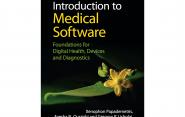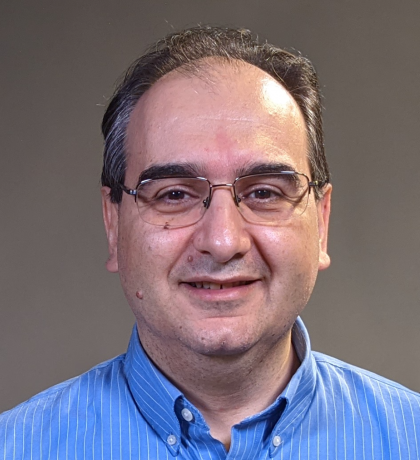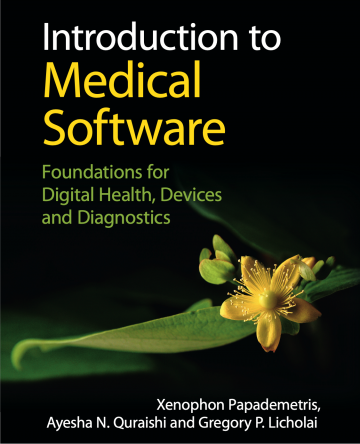Q&A: Prof. Xenios Papademetris on Developing Better Medical Software Applications

With the aim of teaching people how to develop better medical software applications – an increasingly critical aspect of health care – Prof. Xenios Papademetris has co-authored the forthcoming textbook Introduction to Medical Software: Foundations for Digital Health Devices and Diagnostics, published by Cambridge University Press. The book tackles the field of medical software from the technology to the business management side. Papademetris said it came about as a result of teaching a class on Medical Software at Yale, now available to all as an online course from Coursera.
 Papademetris, professor of Radiology and Biomedical Imaging, and Biomedical Engineering, wrote the book with Drs. Ayesha Quraishi and Greg Licholai from the Yale School of Management. We spoke with him about the book, scheduled for release in early May in Europe (and digital formats) and in July in the United States. For more information on the book and the Coursera class see www.medsoftbook.com:
Papademetris, professor of Radiology and Biomedical Imaging, and Biomedical Engineering, wrote the book with Drs. Ayesha Quraishi and Greg Licholai from the Yale School of Management. We spoke with him about the book, scheduled for release in early May in Europe (and digital formats) and in July in the United States. For more information on the book and the Coursera class see www.medsoftbook.com:
- What would you say is the need for this book, and the online course it accompanies?
The book (and the companion Coursera Class) grew out of our Medical Software Design class (BENG 406b). All are motivated by the need to teach students how to create better medical software applications. Most engineers who work in the medical software industry learn their craft “on the job.” I have not seen any textbook at the introductory level that provides a broad overview of the field while including both the technical aspects such as software engineering, statistics, and machine learning and the regulatory side as well. Typically, these topics are covered separately. This is unfortunate, as an understanding of the regulatory constraints can help one better understand how to design both effective and legally compliant software. For example, an understanding of data privacy rules immediately changes how one designs software that uses patient data.
- How can digital health systems, or computer programs, improve health care?
There is probably no area of health care that cannot be improved by better software tools. For example, anything that helps with streamlining information flow and helping doctors see what they need to see in any given context can have a significant impact on how patients are managed and treated. At the next level, we have applications that can help a physician do a better of job of diagnosis. An example of this is the use of automated image analysis and machine learning algorithms in Radiology. Finally, especially in mental health applications, there is the beginning of the use of digital health apps as therapeutics in their own right. Examples of this are tools to help patients manage stress and ADHD.

- The book covers several topics. These include data privacy, quality management systems, risk management, machine learning and raising capital for a new venture. What students do you think are most likely to be interested in the field?
I can see three kinds of students here. In the first category are engineers/computer scientists who would like to learn more about how to create these types of tools. I can see this also being of interest to management students who might perhaps hope to create new healthcare ventures or simply work in digital health/medical device companies. Learning how to manage software projects, especially when software crosses over from being optional to being central to the operation of a device, is an important skill for most managers. Finally, this may be of interest to some medical students who would like to learn how this type of medical technology is created and how to become the invaluable bridge person in helping technical experts create such tools. It is no accident that while I am an engineer, my two co-authors both have medical and management training.
- You’ve said that medical software lies at the intersection of medicine, law, business and management, computer science, and engineering. What do you mean by that?
Medical software is not something that a single person writes in their basement. Software that is used to diagnose or treat patients, for example, requires regulatory review and clearance. This means that the software must be designed to be compliant with the appropriate FDA regulations in the United States and corresponding bodies elsewhere. This is the law aspect, and part of these regulations involve the originating company having an appropriate quality system that is a set of procedures governing all aspects of how this operates. This, together with the expenses involved, requires some management skills. The medicine, computer science and engineering aspects should be easier to see. We must understand the disease area. We need people who know how to code, and we need the biomedical engineering toolset of bridging medicine and technology to be able to integrate the whole process. To give one example: there is a lot of excitement right now about the promise of artificial intelligence or machine learning techniques to improve medicine. However, there are massive challenges in taking these techniques and incorporating them into safe and effective tools that can be used by doctors to treat patients. These range from ensuring robustness, to avoiding bias, to properly integrating these in the current clinical workflow. Software is like an iceberg. The untrained eye sees only the top 10% of it that is above the surface, but the submerged 90% can be just as, or even, more critical.
- What is your long-term goal for the book and the class?
Ultimately, we need more people who know how to create medical software applications. The need for this is enormous both in the United States but also in the rest of the world. My hope is that having the book available will encourage more universities to teach classes in this underserved area. In addition, for new software engineers starting in the medical device industry, perhaps these can be become part of their training programs, whether formally offered or self-directed. The reality is that, at Yale, we only teach a small number of students. Both the book and the online class are an attempt to make this material accessible to people who were not fortunate enough to study here. It is lots of fun to see the Coursera class get to the point where, about six months post launch, we have about 2,650 students enrolled in the class from all continents. For example, close to 10% (9.5% if one wants to be precise) of the students enrolled are from Africa. Not everybody can come to Yale, but perhaps this is a way to take Yale to them!

